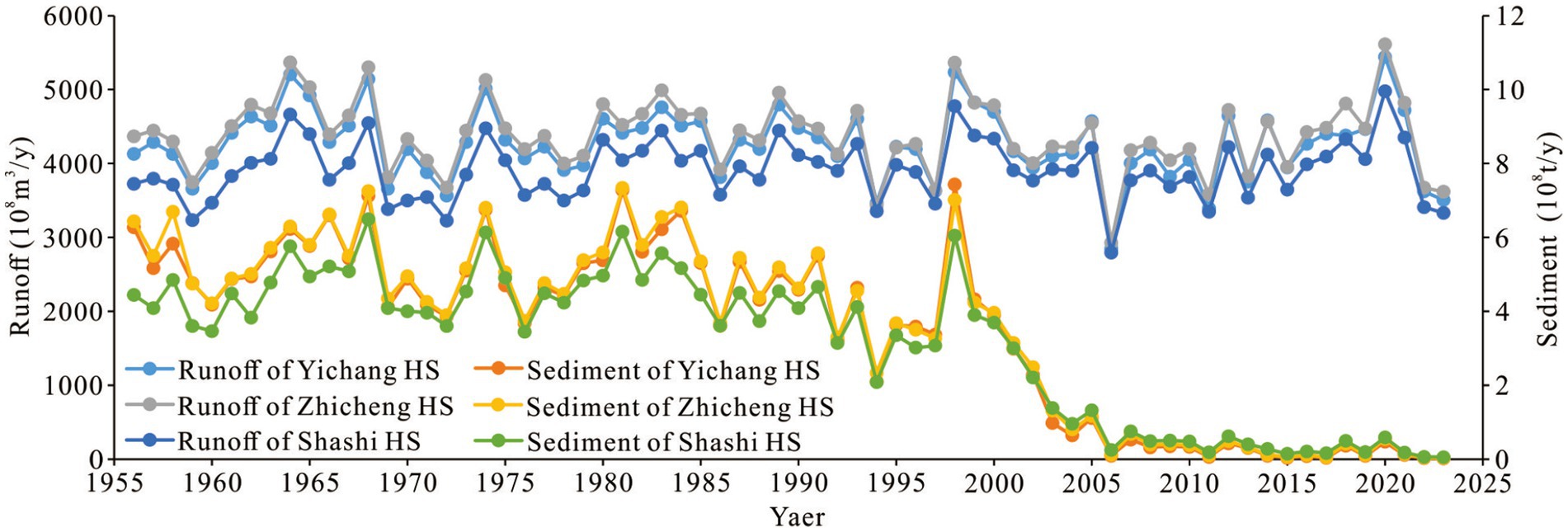- 1Tianjin Water Carriage Engineering Reconnaissance Designing Academy, Tianjin, China
- 2Tianjin Research Institute for Water Transport Engineering, Ministry of Transport, Tianjin, China
- 3Changjiang Waterway Institute of Planning and Design, Wuhan, China
- 4Watershed Hub Operation Management Center, China Three Gorges Corporation, Wuhan, China
- 5Hunan Provincial Communications Planning, Survey & Design Institute Co., Ltd., Changsha, China
Post-commissioning of the cascade reservoir system, substantial riverbed scouring manifested downstream of the primary dam structure. Notable geomorphological adjustments in both the riverbed and adjacent sandbars were observed, particularly under equivalent discharge conditions with depressed water levels. Changes in the hydrodynamic environment related to “steep slopes and rapid flow” remained unclear. We used a section of the Yangtze River (120 km) downstream of the Three Gorges Dam (TGD) and flow sediment, and riverbed topography data (from 2022 to 2023) to analyze the intensity and distribution of riverbed scouring and deposition and changes in water surface gradient under the same flow rate and low-water levels. The low-water and bankfull channels of the Yichang–Dabujie reaches experienced a strong cumulative scouring trend (99.5% concentrated in the low-water channel), and scouring intensity significantly decreased. The sandbar area decreased with a correlated increase in deep-water channels. After implementation, the sandbar and deep-water channel fluctuation range decreased. A cumulative downward trend in flow rate to a low-water level occurred. Sandy sections declined more than sandy-gravel riverbed reach, with an increased water surface gradient, known as the “steep slope” phenomenon. As the sandy to gravel riverbed transition increased, the amplified superimposed “rapid flow” phenomenon increased. Downstream sandy riverbed sections continue to experience strong scouring. Gravel riverbed sections will maintain low-level scouring and remain stable without large-scale human interference. The “steep slope and rapid flow” phenomenon as a dominantin sandy-gravel transition reaches. This stusry systematically elucidated riverbed evolution processes, hydrodynamic regime alterations, and morphological trends downstream of mega-reservoirs, offering critical implications for hydraulic engineering design and navigational safety management.
1 Introduction
After the operation of large reservoirs in alluvial rivers, the amount of sediment volume transported downstream of the dam decreased significantly (Guo et al., 2018; Li et al., 2018; Wang et al., 2016), leading to phenomena such as long-term armored riverbed (Yang et al., 2020, 2023a,b), shrinkage of sandbar areas (Yang et al., 2021, 2023c, 2024a; Zhao et al., 2020), and the lowering of water levels under the same flow rate or low-water conditions (Han et al., 2017; Yang et al., 2017; Yang et al., 2018). Because of the uneven scouring of the riverbed and changes that water levels, the reach near-dam becomes a key area for navigation obstruction. As an important navigable river in China, the Yangtze River’s waterborne freight traffic volume has continuously increased (Li et al., 2020; Weng et al., 2020; Yang et al., 2019; Zhang et al., 2023). However, the increasing demands of shipping development are challenged by the depth of its waterway (Yang et al., 2023c). Studying the characteristics of replace with thalweg depths and sandbars is a primary prerequisite for waterway management. Additionally, because of differences in riverbed geological conditions (Zhang et al., 2017), the decrease in water level under the same flow rate to low-water level is not coordinated with the scouring depth of the riverbed (Han et al., 2017; Yang et al., 2018), resulting in the “steep slope and rapid flow” phenomenon that is not conducive to safe navigation for ships (Li et al., 2021).
Following the commissioning of the Three Gorges Project (TGP), substantial modifications have been observed in the downstream hydrological regime (Zhou et al., 2022), and sediment transport has decreased sharply (Guo et al., 2024; Wang et al., 2021; Zhou et al., 2024). Increased riverbed scouring has occurred in the middle and lower reaches of the Yangtze River to Estuary (Hu and Fang, 2017; Xu et al., 2023). In the early stage of the TGP, the scouring intensity of the riverbed near-dam was relatively high (Han et al., 2017; Yang et al., 2018), and the scouring center gradually shifted downstream a sandy riverbed reach (Luo et al., 2019; Yang et al., 2016; Zheng et al., 2023) and gradually transitioned to a source transfer of scouring with the sandy-gravel riverbed reach (Sun et al., 2011). Following extreme flood events (Wu et al., 2025; Yang et al., 2025), the intensity of riverbed scouring in the mid-lower reaches of the Yangtze River has exhibited an upward trend (Deng et al., 2024; Li et al., 2025). Notably, there are substantial variations in the scouring of sandbars and the sedimentation-erosion dynamics within distributaries. Furthermore, the previously stable diversion relationship among distributaries has been significantly disrupted (Yang et al., 2024b). The maintenance navigation depth in the sandy-gravel section of the middle reaches of the Yangtze River’s sandy-gravel riverbed reach is 3.5 m, lower than the upper Three Gorges Reservoir (TGR) area and the downstream sandy riverbed reach (Yang et al., 2019, 2023c), making it a key navigation obstruction zone. In the early stage of the TGP, after the scouring of the sandy riverbed in the middle reaches and the decline of the water level, the phenomenon of steep slope and rapid flow in the sandy-gravel riverbed reach intensified. Not only did the local slope increase, but more importantly, the effect expanded from a single point to multiple points or from a short distance to a longer stretch (Sun et al., 2007). Heterogeneous water level reductions were observed along the sand-gravel riverbed reaches, attributable to spatial variations in scouring resistance. Projections indicate that reaches exhibiting higher scouring resistance will likely develop navigation constraints, characterized by inadequate water depth and pronounced steep-slope rapid-flow conditions in downstream proximal dam segments (Ge et al., 2009). The section below Changmenxi in the middle reaches of the Yangtze River will be unable to withstand the downward transfer of water level drop, with a more severe steep slope, rapid flow, and shallow water phenomena expected in the dry season above Majiadian section (Sun et al., 2011). After the Three Gorges Reservoir (TGR) impoundment, the water levels above the Lujiahe reach in the dry season are mainly restricted by the sandy-gravel in the Yichang–Zhijiang reaches, with the Lujiahe reach control nodes showing the most significant effect (Cheng et al., 2011). The scouring and incision of the riverbed in the sandy-gravel riverbed reach is the main reason for the water level decline under the same flow rate conditions in the dry season. Still, the riverbed coarsening has reduced the extent of the decrease in water levels to a certain extent (Li, 2017). In recent years, the riverbed in the rapids area in the transition zone from gravel to sandy-gravel reach has continuously scouring, and there has been a phenomenon of short-distance transport of sandy-gravel riverbed reach, which is the main cause of navigation obstruction in the Lujiahe reaches (Li et al., 2021). By using a three-dimensional mathematical model, the simulation and calculation suggest that the “waterway dredging stabilization” approach can solve the “shallow, steep, and rapid” navigation obstruction problems in the sandy-gravel riverbed reach (Liu et al., 2010; Suo et al., 2020; Xiong et al., 2019; Yu and Wang, 2024), which has a small impact on water levels and reduces the flow velocity in dredging zones (Dong et al., 2020), thus reducing the movement intensity of the sandy-gravel riverbed reach. After the operation of the TGP, the reduction of flood flow and the increase in dry-season days are not conducive to the long-distance transport of sandy-gravel riverbed reach. In contrast, the upstream scouring and transmission caused by the water level drop has caused scouring in the areas that were previously stable on the low-water flow path (Xiong et al., 2020). For the 800-kilometer river reach downstream of the TGD, the most severe erosion during the initial operational phase of the TGR primarily occurred in gravel and cobblestone-dominated river sections. Recent observations indicate a downstream migration of the scouring center. Researchers have attributed these spatial variations in scouring intensity to multiple factors including hydrological characteristics (runoff volume), sediment dynamics (transport volume), and morphological changes in riverbed composition (Yang et al., 2023a). Studies have focused on reviewing the intensity of riverbed scouring and deposition, changes in waterway conditions, and causes of the formation of the sandy-gravel riverbed reaches in the Yangtze River, as well as the “steep slope and rapid flow” phenomenon. However, they failed to predict the development trend of “steep slope and rapid flow” in sandy-gravel riverbed reaches, which was caused by riverbed scouring and deposition, and to adapt the flow rate to low-water levels simultaneously.
This study takes the 120 km reach of the Yangtze River downstream of the TGD (from Yichang to Dabujie reaches) as the study object, using actual measured hydrological, sediment, and riverbed topographic data collected during 2022–2023 to analyze the scouring intensity, sandbar, and deep-water channel area changes, and their interrelationships, identifies the characteristics of water level changes under the same flow rate and low-water conditions, and explores the formation, influencing relationships, and development mechanisms of the “steep slope and rapid flow” phenomenon related to shipping hydrodynamics.
2 Materials and methods
2.1 Research area
The Yangtze River, Asia’s longest watercourse, originates from the Tanggula Mountains (Tibetan Plateau) with a total length of approximately 6,397 km according to latest hydrological surveys. The upstream section is from the source to Yichang City, the middle reaches is from Yichang to Hukou and the downstream section is below Hukou (Figure 1a). The research area in this study is the section from Yichang to Dabujie, with a river channel length of 120 km. The riverbed of the Yichang–Zhicheng reaches is sandy-gravel and sandy riverbed, the Zhicheng–Dabujie reaches is a sandy-gravel to sandy mixed riverbed, and the reach below Dabujie is sandy riverbed (Figure 1b). The TGD is located upstream of the study area, and the TGR was put into operation in June 2003. The period from 2003 to 2006 was the cofferdam impoundment period, from 2007 to 2008 was the early impoundment period, and since 2009 was the experimental impoundment period, with water levels in the reservoir being 135–145 m, 156 m, and 175 m, respectively. The study area includes monitoring stations such as the Yichang Hydrographic Station (HS), Zhicheng HS, and downstream Shashi HS, and over 20 water level monitoring stations are distributed along the river channel. Yanzhiba, Nanyangqi, Guanzhou, Qiba, Shuiluzhou, Liutiaozhou, and their islands are distributed in the Yichang–Dabujie reaches, and their shoal and deep-water channel morphology is the key area of concern for navigation construction (Figure 1b).

Figure 1. Yangtze River Basin location and study area river channel map. (a) Map of the Yangtze River Basin; (b) river channel map downstream of the TGD.
2.2 Research data and sources
2.2.1 Research data
We collected daily average flow, water level, and sediment concentration data from Yichang, Zhicheng, and Shashi HSs from 2003 to 2023. We mainly analyzed the changes in runoff and sediment transport, as well as the variations in the flow during the same flow rate to low-water level, minimum flow, and minimum water level. The water level measurement data along the Yichang–Shashi reaches from 2003 to 2023 were also collected to analyze the change in the water surface line, water surface slope, and other characteristics. Geomorphic elevation data (the measurement scale is 1:10,000) from the Yichang–Shashi reaches during the same period were collected to analyze bedload scouring and deposition, sandbar morphology, thalweg, and cross-section, and the areas of shoals and deep-water channels, as well as to investigate the impact of bedload scouring and deposition on water level changes. The maintenance water depth data of the main waterway channel of the Yangtze River from 2003 to 2023 were also collected to analyze the impact of bedload scouring and deposition and changes in water level at the same flow rate on the characteristics of “steep slopes and rapid flow.” The above-measured data (Table 1) were mainly obtained from research institutions, including the Yangtze River Water Conservancy Committee Hydrological Bureau, the Yangtze River Waterway Planning Design and Research Institute, and the Yangtze River Waterway Bureau.
2.2.2 Riverbed scouring and deposition calculation methods
The water level elevation corresponding to the low and normal flat is determined based on the relationship between the water level and flow rate at hydrological stations in the river section and the terrain conditions. Sections of the river channel are cut along the river map. Under the corresponding water level conditions, the water flow area of the riverbed at the upper and lower sections was calculated. The section method calculates the river channel storage between the two sections at the corresponding water levels (Yang et al., 2020, 2021). The formula (Equation 1) is as follows:
where: Ai, Ai + 1 are the water flow areas at the upper and lower river sections, in m2; Li is the distance between sections, in m; Vi(Zi) is the channel storage volume between two sections at the corresponding water levels, in m3. The river channel storage between each calculated section is accumulated, and the total river storage at the corresponding water level for the river section is V = ▵Vi.
The statistical analysis of river channel scouring and silting processes is categorized into low-water channel and bankfull channel components based on riverbed elevation differentials. Detailed computational methodologies for these analyses are documented in the studies by Yang et al. (2020, 2021).
2.2.3 Hydrodynamic indicator calculation method
1. Water level difference and water surface gradient calculation method.
The water level difference and water surface gradient are important hydrodynamic indicators of the river channel. The calculation formula of water level difference and water surface gradient ( ) along the river section (Equations 2, 3) are as follows:
1. Same flow rate and low-water level calculation method.
Actual daily average flow rate (Q) and water level (H) data are collected from HSs. The relationship curve between flow rate and water level is fitted using a logarithmic equation (Equation 4) as follows:
3 Results
The study studied the riverbed scouring and deposition volume and intensity, the areas of shoals and deep-water channels, and the temporal and spatial characteristics of cross-section and deep-water channel changes along the Yichang–Dabujie reaches. The minimum flow, the lowest water level, and flow rate to low-water level relationships were clarified, and the changes in the water surface line, water surface slope, and local flow fields that affect navigation were also identified.
3.1 Riverbed shoal and deep-water channel morphological evolution characteristics
3.1.1 Riverbed scouring and deposition volume and distribution characteristics
During the period from 2003 to 2023, the cumulative scouring volume of low-water and bankfull channels in the Yichang–Zhicheng reaches was 1.54 × 108 m3 and 2.16 × 108 m3, respectively, and the evolutionary characteristics were “uniform scouring of shoals and deep-water channels” (Figures 2a,f). From 2003 to 2023, the cumulative scouring volume of low-water and bankfull channels in the Zhicheng–Dabujie reaches was 1.67 × 108 m3 and 2.05 × 108 m3, respectively, showing the evolution of “scouring of deep-water channels and deposition of shoals” (Figures 2b,f). For the Yichang–Dabujie reaches, the cumulative scouring volume of low-water and bankfull channels was 3.70 × 108 m3 and 3.72 × 108 m3, with approximately 99.5% of the total scouring concentrated in the low-water channel (Figure 2c). In the Yichang–Zhicheng reaches, the scouring volumes of the low-water and bankfull channels accounted for 72.6 and 71.0% of the total scouring from 2003 to 2009, respectively, and proportions decreased to 21.7 and 23.6% from 2009 to 2023. The scouring intensity center shifted to the Zhicheng–Dabujie reaches (Figure 2d).
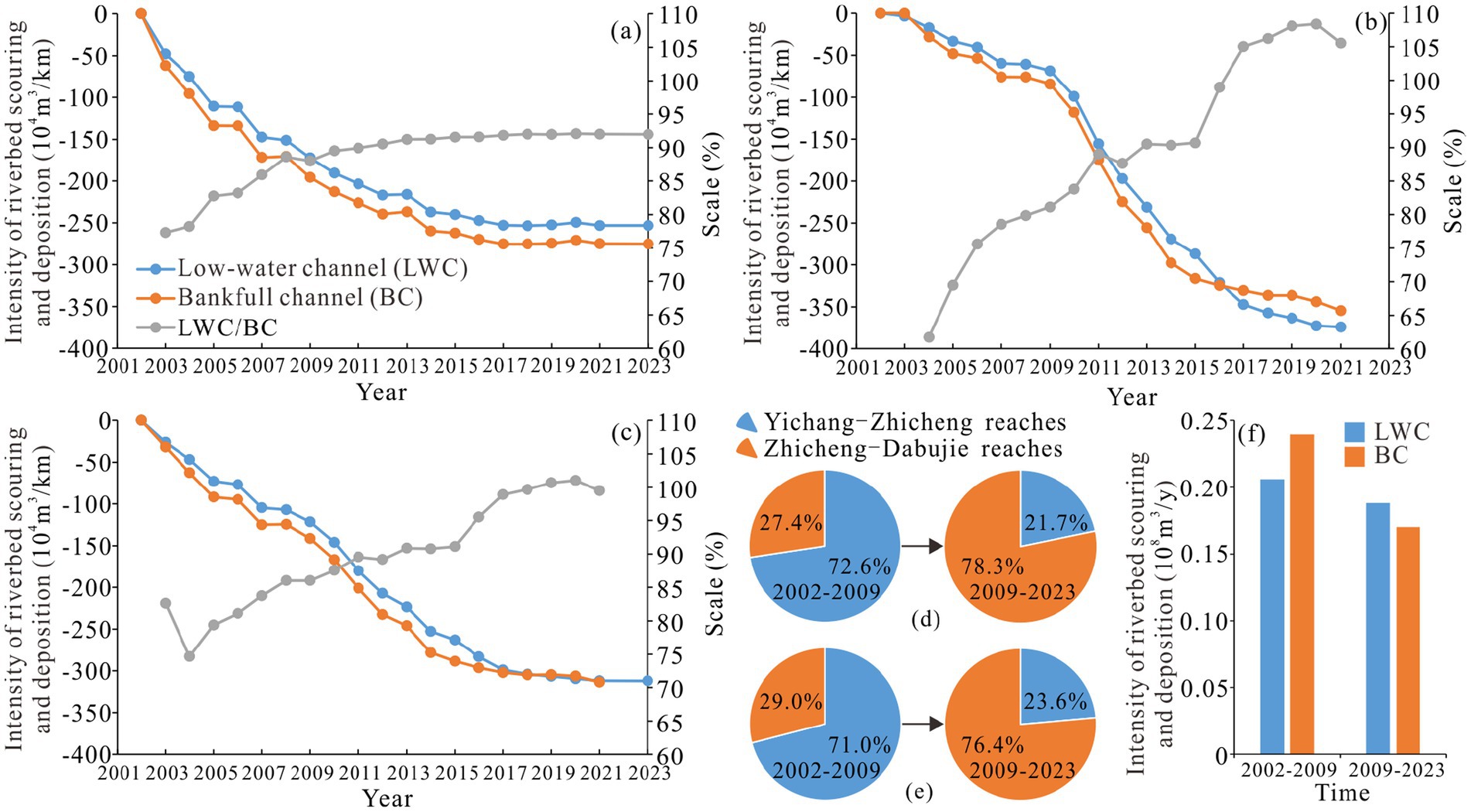
Figure 2. Riverbed scouring and deposition intensity and distribution characteristics. (a) Yichang–Zhicheng reaches; (b) Zhicheng–Dabujie reaches; (c) Yichang–Dabujie reaches; (d) distribution characteristics of scoured river segments during low-water channel; (e) distribution characteristics of scoured river segments in bankfull channels; (f) Temporal and spatial distribution characteristics of scouring and deposition in the riverbed.
3.1.2 Changes in shoal and deep channel area
Along the Yichang–Dabujie reaches are shoals and deep-water channels developed in Yanzhiba, Yidu, Guanzhou, Lujiahe, Dongshi, and Liutiaozhou reaches. The interaction betwe shoals and deep channels was analyzed based on area as a parameter. The 2002 topographic survey showed that the areas of the deep-water channels at Yanzhiba (Figure 3a, 25 m contour lines), Yidu (Figure 3b, 25 m contour lines), Guanzhou (Figure 3c, 20 m contour lines), Lujiahe (Figure 3d, 25 m contour lines), Dongshi (Figure 3e, 25 m contour lines), and Liutiaozhou (Figure 3f, 25 m contour lines) were 1.225 × 106 m2, 0.964 × 106 m2, 0.072 × 106 m2, 0.981 × 106 m2, 0.158 × 106 m2, and 2.429 × 106 m2, respectively. In 2023, the areas were 1.354 × 106 m2, 2.520 × 106 m2, 1.595 × 106 m2, 2.666 × 106 m2, 0.507 × 106 m2, and 7.453 × 106 m2. The overall deep-water channel area indicated a significant increase. The 2002 topographic survey showed that the areas of shoals at Yanzhiba (39 m contour lines), Yidu (33 m contour lines), Guanzhou (35 m contour lines), Lujiahe (35 m contour lines), Dongshi (35 m contour lines), and Liutiaozhou (35 m contour lines) were 1.889 × 106 m2, 0.820 × 106 m2, 4.830 × 106 m2, 0.670 × 106 m2, 1.160 × 106 m2, and 1.564 × 106 m2, respectively. In 2023, the areas were 1.718 × 106 m2, 0.289 × 106 m2, 3.075 × 106 m2, 0.190 × 106 m2, 0.882 × 106 m2, and 0.985 × 106 m2, showing a decrease in total shoal area (Figure 3). Since 2009, a series of channel regulation projects have been implemented along the Yichang–Dabujie reaches. After implementing these projects, the shoal area has remained relatively stable. In contrast, the deep-water channel area has increased, demonstrating that waterway engineering has played the role of “stabilizing the shoals and scouring the deep-water channels.”
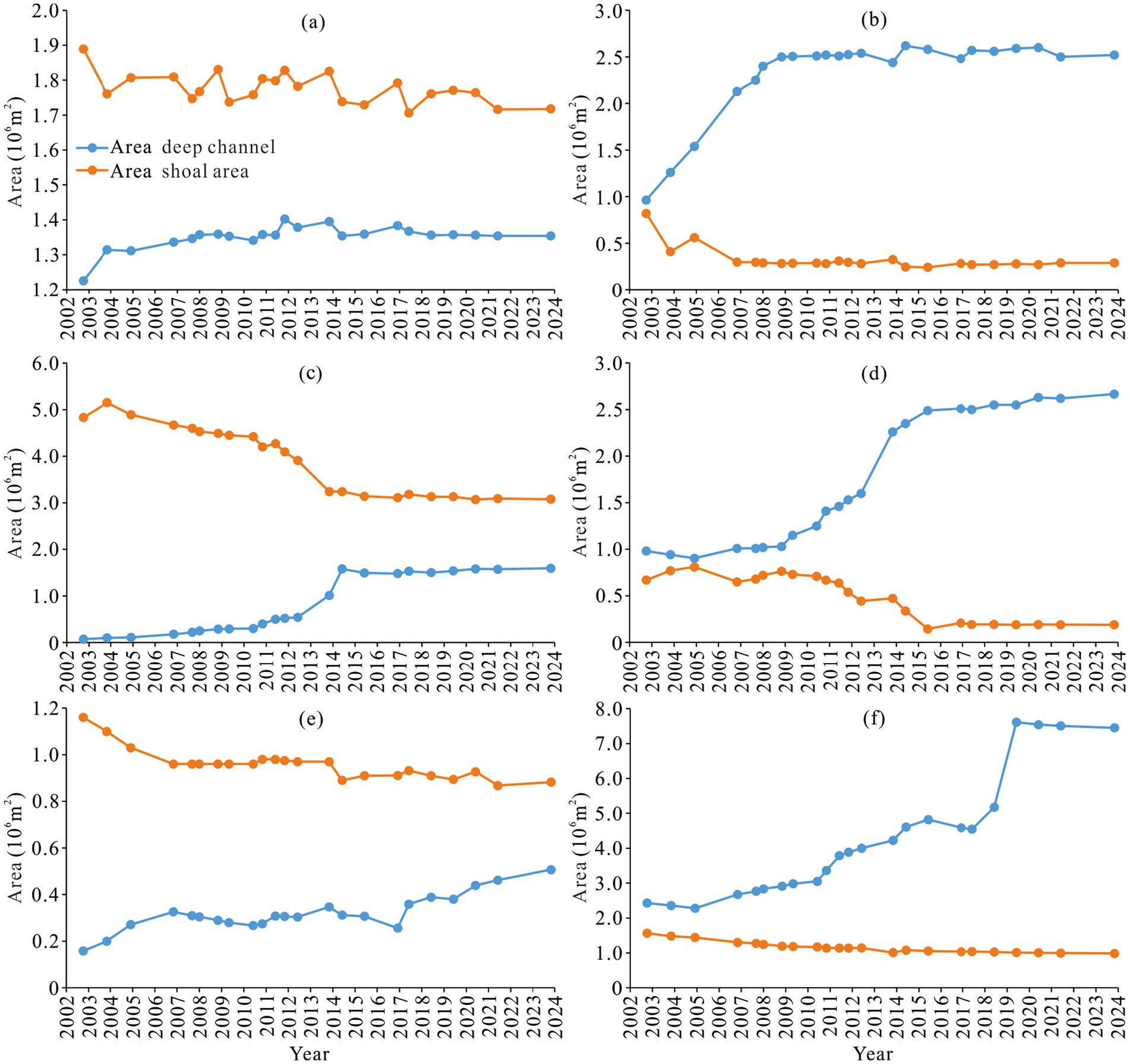
Figure 3. Changes in deep-water channel and shoal area along the Yichang–Dabujie reaches. (a) Yanzhiba reach; (b) Yidu reach; (c) Guanzhou reach; (d) Lujiahe reach; (e) Dongshi reach; (f) Liutaiozhou reach.
From 2002 to 2023, the total area of deep-water channels in the Yichang–Dabujie reaches increased from 5.829 × 106 m2 in October 2002 to 16.094 × 106 m2 in October 2023 (a 176.1% increase). Furthermore, the total area of shoals decreased from 10.933 × 106 m2 in October 2002 to 7.138 × 106 m2 in October 2023 (a 34.7% decrease) (Figure 4a). Between 2002 and 2023, there was a strong correlation between the areas of shoals and deep-water channels along the Yichang–Dabujie reaches (R2 = 0.96). However, during the period after the implementation of waterway engineering from 2014 to 2023, the correlation between shoals and deep-water channels weakened (R2 = 0.46), indicating that the implementation of waterway engineering has gradually changed the riverbed evolution process of the river channel and replace with coupling between channel morphology and sediment (Figure 4b).
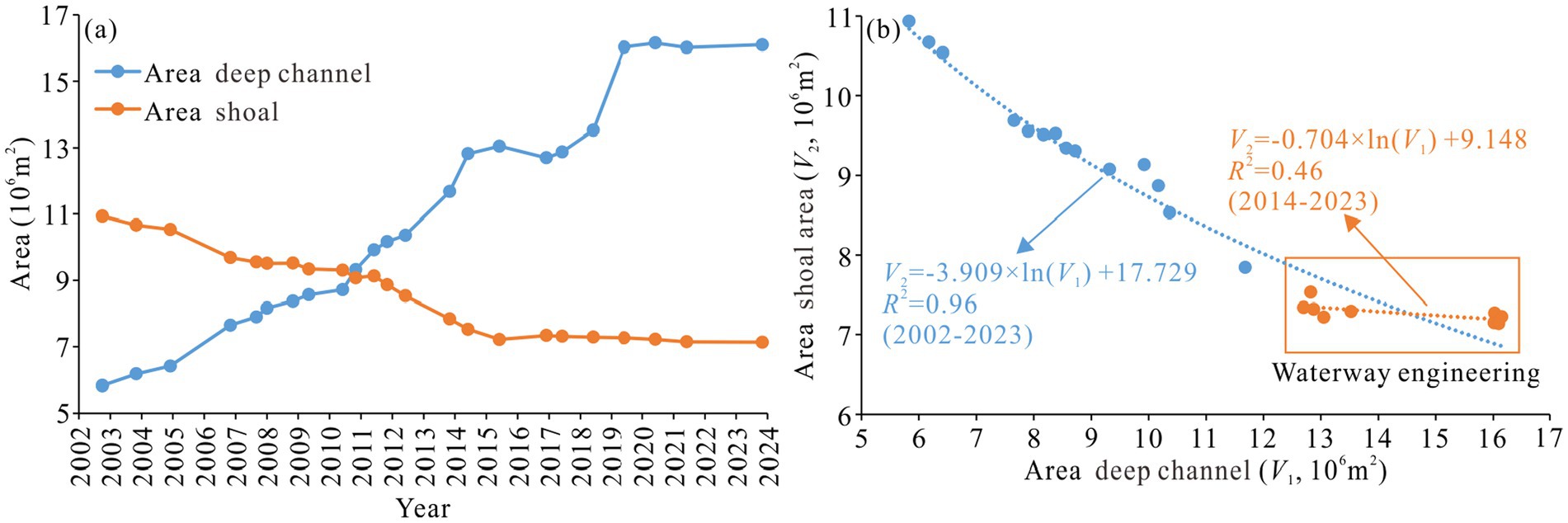
Figure 4. Interaction between deep-water channel and shoal area along the Yichang–Dabujie reaches. (a) Variations in the areas of deep-water channels and shoals; (b) relationship between the areas of shoals and deep-water channels.
3.1.3 Changes in riverbed cross-section morphology
Between 2002 and 2021, the average incision depth of thalweg in the Yichang–Dabujie reaches was 4.12 m, and the annual average incision depth was 19.62 cm/year. The maximum incision depth was 23.40 m (Figure 5a). From 2022 to 2023, the average incision depth in the Yichang–Zhicheng reaches and Zhicheng–Dabujie reaches was 4.31 m and 4.09 m, respectively. In the near-dam section, the incision depth in the shallow bedrock riverbed area was 1.93 m (Figure 5a). In terms of cross-sectional morphology changes, the change in the higher level of the thalweg was small after the surface sand-gravel layer in the areas with shallower bedrock was scoured (Figure 5b). In sections with gravel surface and sandy riverbed, the cross-sectional morphology of this section changed little after the fine-grained sediment in the surface sand-gravel layer was scouring. From 2002 to 2014, the scouring trend occurred at sections 1#, 2#, and 3#, with smaller scouring from 2014 to 2021 (Figures 5c–e).
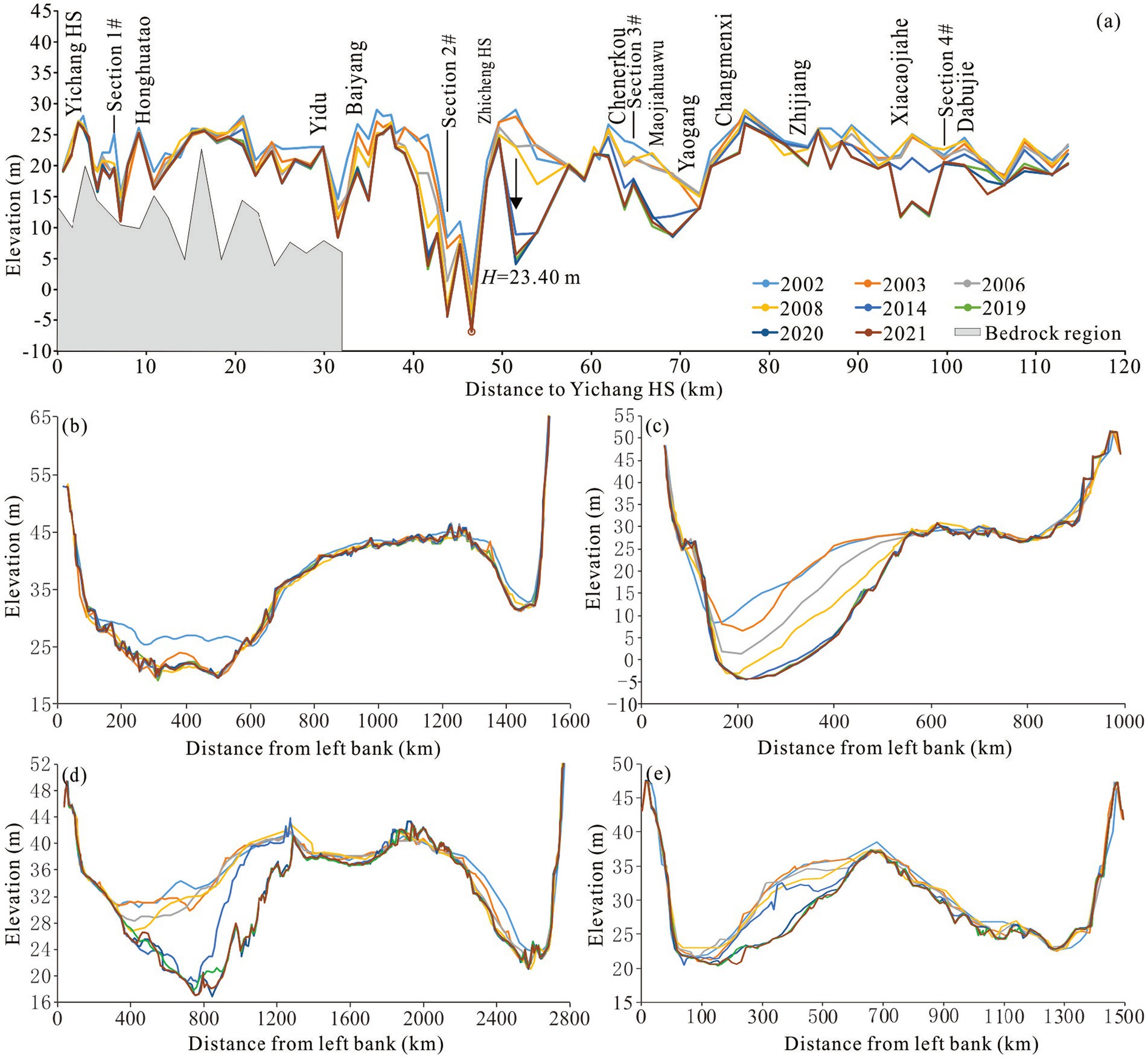
Figure 5. Changes in thalweg and cross-section along the Yichang–Dabujie reaches. (a) Elevation changes of the thalweg; (b) cross-section 1#; (c) cross-section 2#; (d) cross-section 3#; (e) cross-section 4#.
3.2 Change characteristics in mid-low water levels
3.2.1 Changes in minimum flow and minimum water level
From 2003 to 2023, the minimum flow at Yichang HS, Zhicheng HS, and Shashi HS increased from 3,670 m3/s, 3,890 m3/s, and 4,150 m3/s in 2002, to 6,610 m3/s, 7,110 m3/s, and 6,910 m3/s in 2023, with increases of 80.1, 82.8, and 66.3%, respectively (Figures 6a–c). From 2002–2023, the minimum water level and minimum flow at Yichang HS and Zhicheng HS increased synchronously, with coefficients of determination (R2) of 0.93 and 0.91, respectively (Figure 6d). At Shashi HS, from 2003 to 2009, the relationship was also synchronized (with R2 = 0.71), and from 2010 to 2023, minimum flow increased while the corresponded minimum water level decreases, indicating that the underlying surface water level in the Yichang–Dabujie reaches was in a decreasing trend (Figure 6d). The sandy riverbed sections in the middle Yangtze River have exhibited intensified scouring patterns since 2010. Notably, the magnitude of riverbed incision has surpassed concurrent water level reductions. Hydrological observations at Shashi HS (2010–2023) reveal an inverse correlation between discharge rates and low-water levels, with the latter demonstrating a consistent declining trend during this period.

Figure 6. Changes in minimum flow and minimum water level at HS. (a) Yichang HS; (b) Zhicheng HS; (c) Shashi HS; (d) correlation between flow and water level.
3.2.2 Changes in same flow rate and low-water level
From 2003–2023, the same flow rate to low-water levels at Yichang, Zhicheng, and Shashi HSs decreased. At Yichang HS, the cumulative decrease in water levels corresponding to 6,000 m3/s, 6,500 m3/s, and 7,000 m3/s was 0.75 m, 0.79 m, and 0.82 m, respectively (Figure 7a). At Zhicheng HS, the cumulative decrease in water levels corresponding to 7,000 m3/s, 8,000 m3/s, and 9,000 m3/s was 0.53 m, 0.70 m, and 0.83 m, respectively (Figure 7b). At Shashi HS, the cumulative decrease in water levels corresponding to 6,000 m3/s, 7,000 m3/s, and 10,000 m3/s was 3.42 m, 3.24 m, and 2.94 m, respectively (Figure 7c).
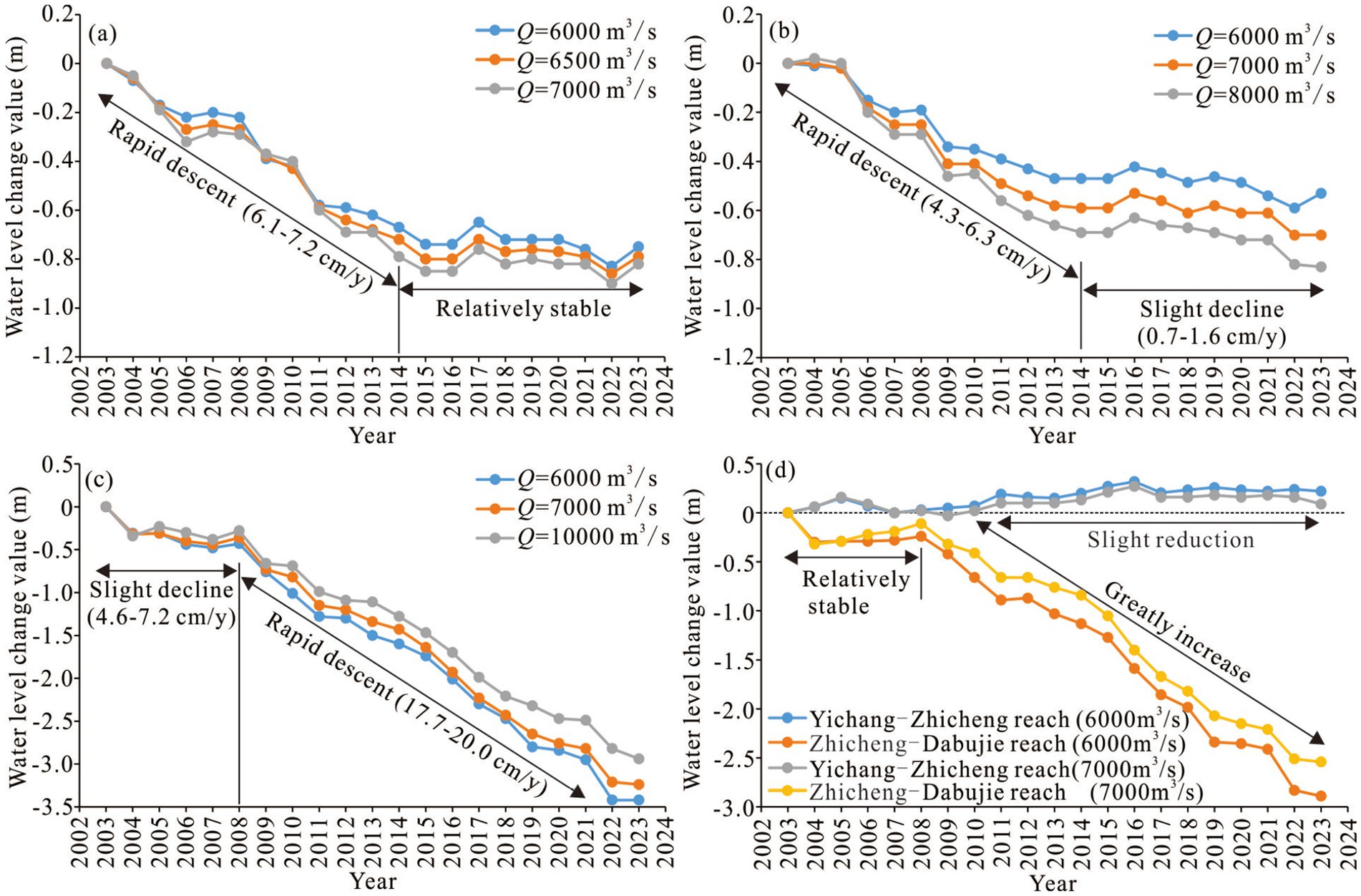
Figure 7. Characteristics of low-water level changes in the Yichang–Dabujie reaches. (a) Yichang HS; (b) Zhicheng HS; (c) Shashi HS; (d) flow and water level relationship.
From 2003 to 2014, the water levels corresponding to flows at 6,000–7,000 m3/s at Yichang and Zhicheng HSs showed rapid decreases, with rates of 6.1–7.2 cm/year and 4.3–6.3 cm/year, respectively. From 2014 to 2023, the water level at Yichang HS remained relatively stable from the same flow rate to low-water level, whereas the water level at Zhicheng HS declined slightly (water level decrease rate between 0.7 and 1.6 cm/year) (Figures 7a,b). Between 2003 and 2008, the water level decrease rate at Shashi HS corresponding to 6,000–10,000 m3/s ranged at 4.6–7.2 cm/year, whereas from 2008 to 2023, the decrease became more significant, reaching 17.7–20.0 cm/year (Figure 7c). From the water level difference along the river, the accumulated water level difference between Yichang and Zhicheng reaches showed little variation (less than 0.30 m). However, the accumulated water level difference between Zhicheng and Shashi increased significantly, indicating that this section exhibited a steeper water level gradient during the day season (Figure 7d).
3.3 “Steep slope and rapid flow” characteristics
The gravel-to-gravel transitional section of the Yangtze River has the characteristics of a mountainous river, and “steep slope and rapid flow” is a key hydrodynamic factor affecting safe navigation. Affected by the uneven riverbed scouring and water level adjustment, the change characteristics of low-water surface, water surface gradient, and maximum flow velocity were studied, and the evolution process and development trend of the “steep slope and rapid flow” were analyzed.
3.3.1 Changes in water surface line
During the low-water season at Yichang HS, the water level differences in the reach between Zhicheng and Dabujie were large, and the water level differences between upstream and downstream areas were small. As the flow at Yichang HS increased, the water surface slope gradually decreased (Figure 8a). Using Yichang HS Q = 6,000 m3/s as a reference, the water levels in the Yichang–Shashi reaches during 2003–2023 were calculated. The results showed that compared 2003–2023, the water level difference in the Yichang–Baiyang reaches, Zhicheng–Chenerkou reaches, and Chenerkou–Shashi reaches were 0.48–0.69 m, 0.30–0.38 m, and 0.86–3.30 m, respectively (Figure 8b), with the Zhicheng–Chenerkou reaches being the main control point for low-water levels.
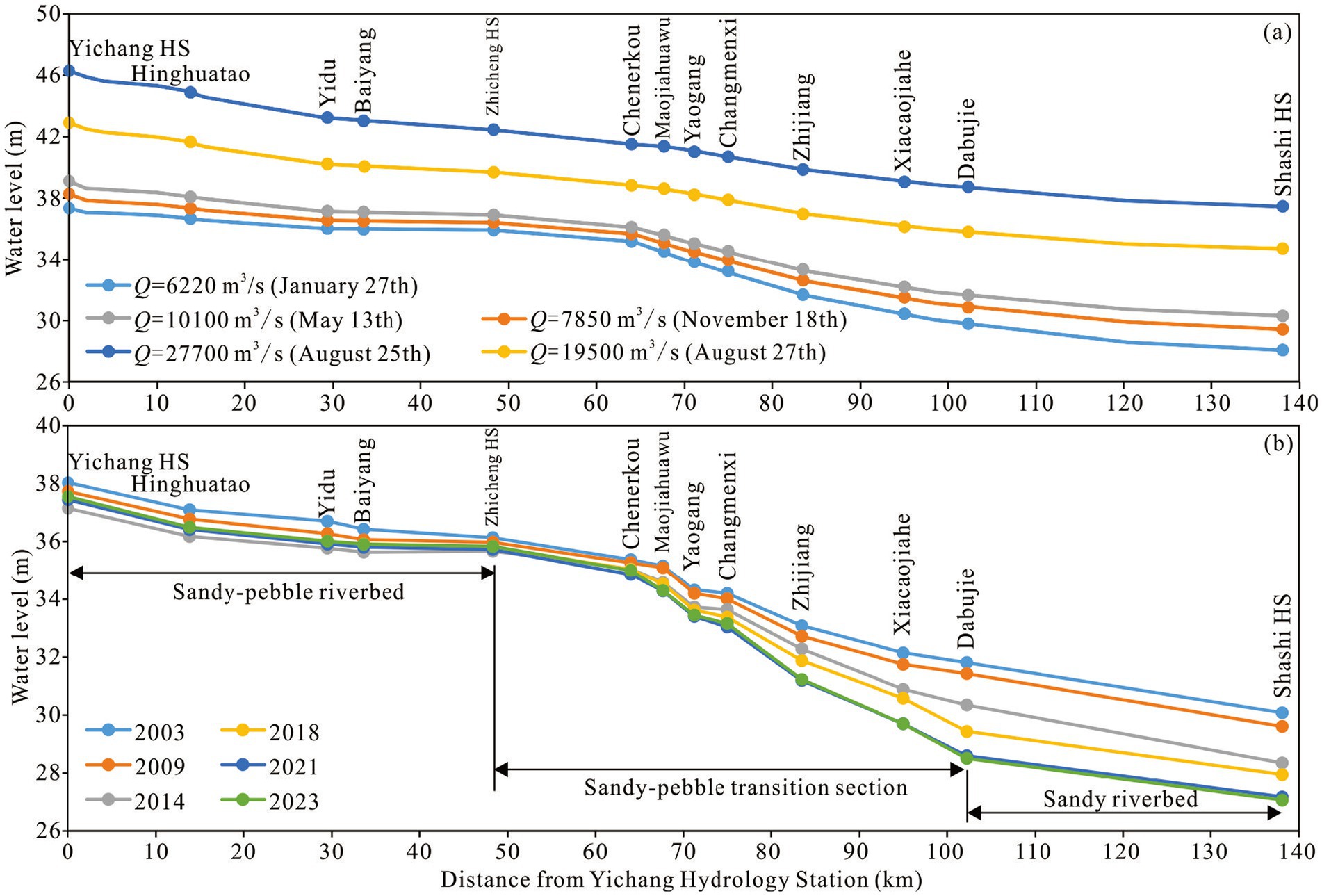
Figure 8. Water surface line changes along the Yichang–Shashi reaches. (a) Water level variations under different flow conditions, the measurement time is 2023; (b) temporal and spatial changes in water level at consistent flow rates.
In summary, the water surface gradient of the Zhicheng–Dabujie reaches is greater than that of the upstream Yichang–Zhicheng reaches and the downstream Dabujie to Shashi reaches, showing the characteristics of a steep drop in the water surface. In addition, the water surface gradient of the Zhicheng–Dabujie reaches during the low-water period from 2015 to 2023 showed an increasing trend, whereas the Dabujie–Shashi reaches showed a decreasing trend.
3.3.2 Changes in water surface gradient
The “steep slope” phenomenon formed from the Zhicheng–Dabujie reaches from the water level difference and surface gradient. From 2003 to 2009, 2010–2014, and 2015–2023, the water surface gradient between Yichang and Zhicheng increased as the flow increased, with the relationship curve remaining relatively stable (Figure 9a). From 2003–2009, 2010–2014, and 2015–2023, during the mid-dry season (Q ≤ 15,000 m3/s), the water surface gradient in the Zhicheng–Dabujie reaches decreased as the flow increased at Zhicheng HS. The water surface gradient changed little when the flow exceeded 15,000 m3/s (Figure 9b). From 2003–2009 and 2010–2014, there was little change in the water surface gradient between the Dabujie–Shashi reaches. From 2015 to 2023, the water surface gradient first decreased and then increased as the flow rate increased, showing a decreasing trend compared to the 2003–2014 period (Figure 9c). During the 2003–2014 period, the water level difference and water surface gradient in the Yichang–Zhicheng, Zhicheng to Dabujie, and Dabujie to Shashi reaches were relatively stable. From 2014 to 2023, the water level difference and water surface gradient in the Yichang–Zhicheng reaches slightly increased, the Zhicheng–Dabujie reaches showed an increasing trend, and the Dabujie–Shashi reaches decreased slightly (Figures 9d,e).
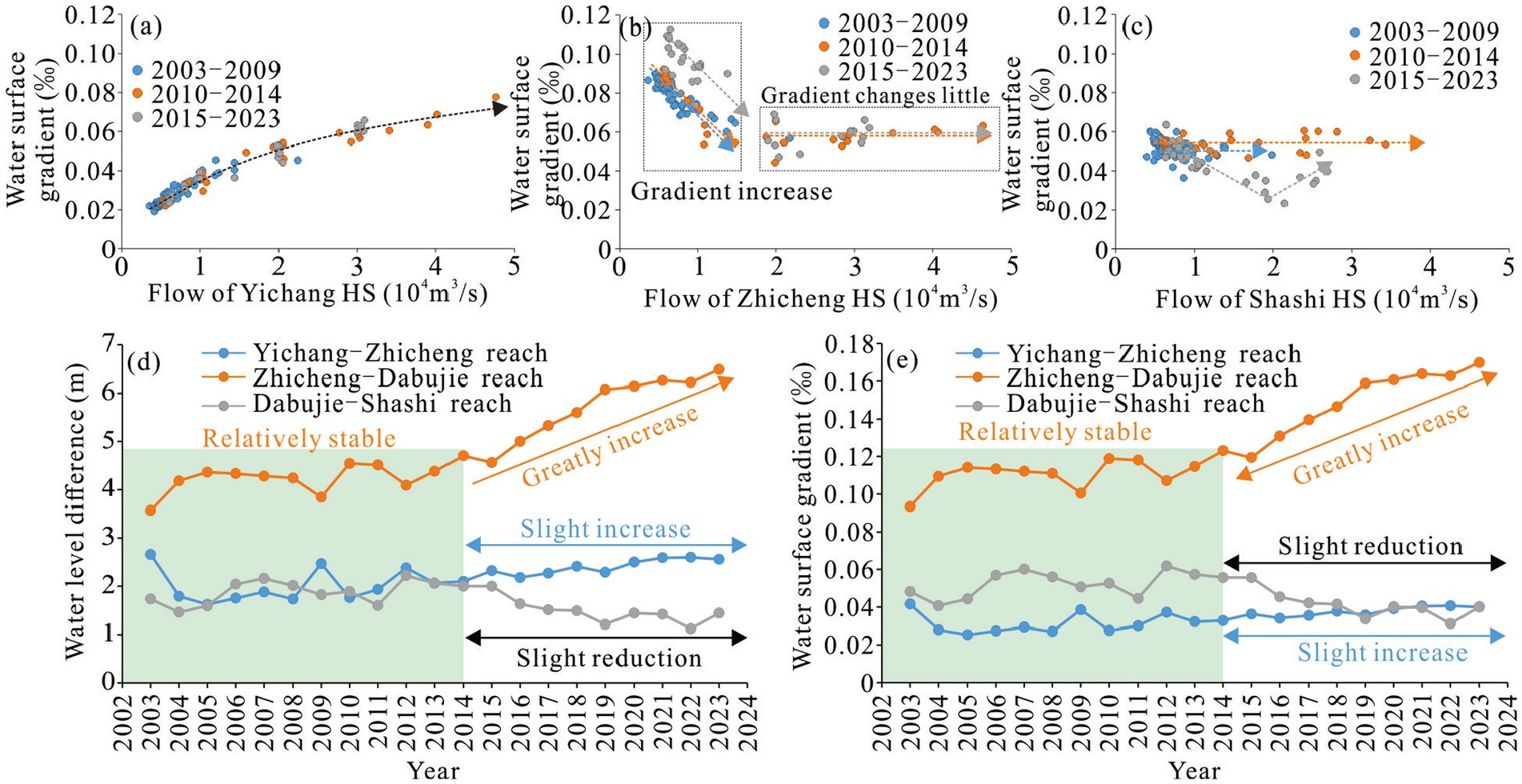
Figure 9. Changes in water level difference and water surface gradient from Yichang–Shashi reaches. (a) Yichang–Zhicheng reaches; (b) Zhicheng–Dabujie reaches; (c) Yichang–Dabujie reaches; (d) water level difference changes under consistent flow conditions; (e) water surface gradient changes under consistent flow conditions.
3.3.3 Changes in maximum flow velocity
The planned ship capacity for the Jingjiang reaches in the middle reaches of the Yangtze River is 5,000 tons, the upper beach flow velocity is less than 2.8 m/s, and the gradient is less than 8‱. From 2005 to 2018, the maximum flow velocity in the Zhicheng–Changmenxi reaches was 3.28 m/s (occurred in 2020, Figure 10), which is not conducive to safe navigation. With the riverbed scouring and the implementation of waterway engineering, the waterway water depth in the Zhicheng–Changmenxi section increased from 2.9 m in 2002 to 4.2 m in 2023, significantly improving the waterway scale. For the planned waterway scale of 4.5 m × 200 m × 1,050 m, the obstruction characteristics are that the navigation width does not meet the 200 m requirement, and the obstruction zones are located at the right branch of Guanzhou and the left branch of Lujiahe.
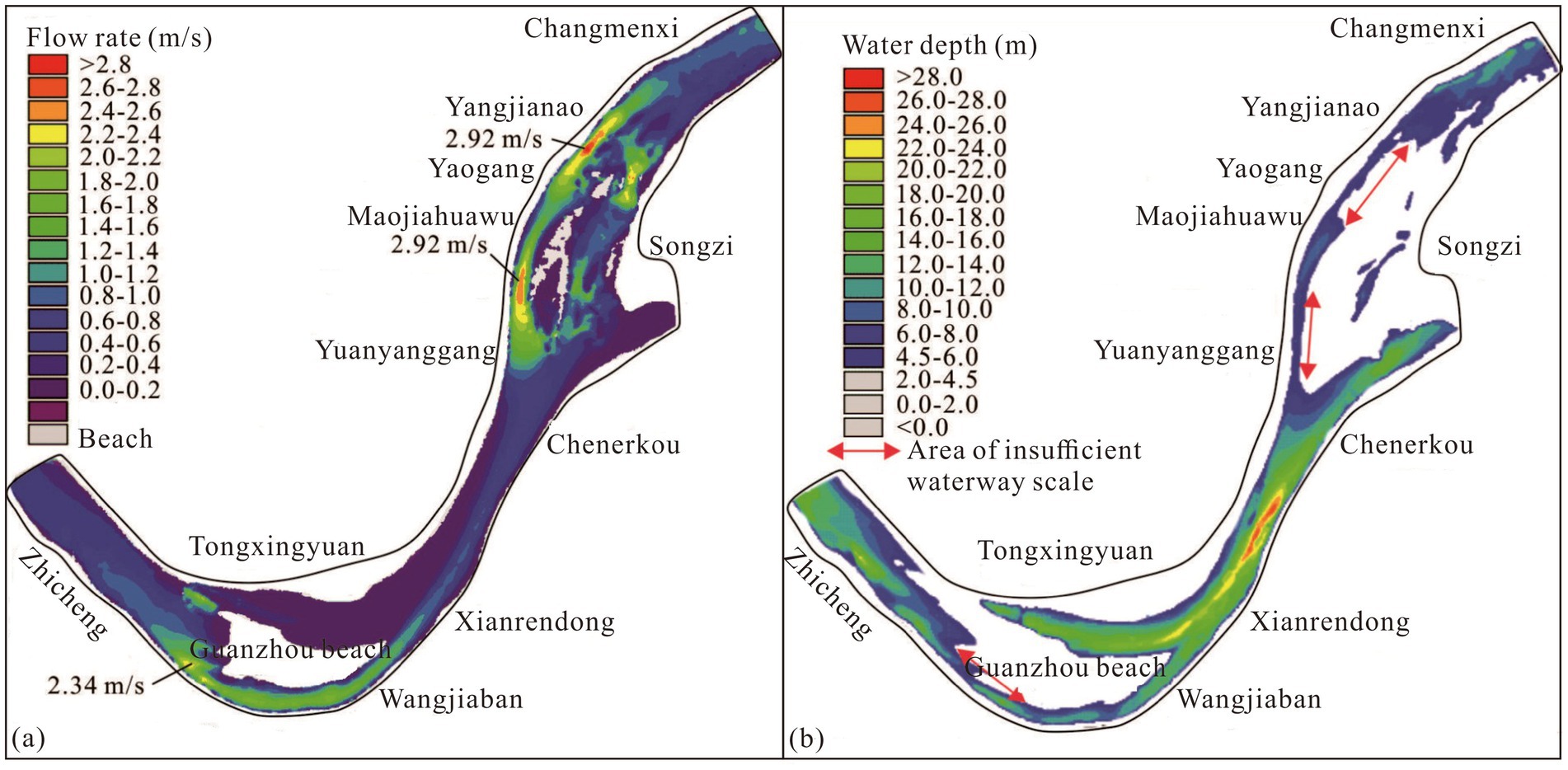
Figure 10. Changes in flow velocity and water depth in the sand-gravel to sandy riverbed transition section. (a) Velocity distribution characteristics; (b) waterway water depth distribution characteristics.
From 200 to 2006, the maximum surface flow velocity in the Lujiahe reach decreased with increasing low-water flow, showing a high correlation (Figure 11a). From 2014 to 2021, the surface maximum flow velocity in the Lujiahe reach reached 3.50 m/s, occurring near Maojiahuawu section. The value was higher than the corresponding flow velocity during the 2005–2006 period at the same flow rate (Figure 11b). Overall, the Lujiahe reach still exhibits a significant “steep slope and rapid flow” phenomenon. The increase in ship tonnage has enhanced the adaptability to flow velocity, and small ships still face navigation safety issues.

Figure 11. Changes in maximum flow velocity in the Lujiahe reach. (a) Distribution characteristics of flow velocity; (b) distribution characteristics of water depth.
4 Discussion
This section focuses on analyzing the impact of the cumulative scouring intensity of the riverbed on the water level drop from the Yichang–Dabujie reaches and the changing trend of riverbed scouring and deposition combining changes in runoff and sediment conditions. From the perspective of the low-water level and the design minimum navigable water level, the relationship between the evolution of the sandbars and deep-water channels, water level changes, and navigation waterway depth resources is discussed.
4.1 Trend analysis of riverbed scouring based on runoff and sediment conditions
From 1956 to 2002, the annual runoff for Yichang HS, Zhicheng HS, and Shashi HS was 4,326 × 108 m3/year, 4,444 × 108 m3/year, and 3,931 × 108 m3/year, respectively (Figure 12). From 2003 to 2023, these values decreased to 4,136 × 108 m3/year, 4,248 × 108 m3/year, and 3,877 × 108 m3/year, with reductions of 4.39, 4.43, and 1.38%, respectively. During 1956–2002, the sediment transport for Yichang, Zhicheng, and Shashi HSs was 4.911 × 108 t/year, 5.008 × 108 t/year, and 4.323 × 108 t/year, respectively. From 2003–2023, these values dropped to 0.308 × 108 t/year, 0.372 × 108 t/year, and 0.461 × 108 t/year, with reductions of 93.74, 92.58, and 89.34%, respectively (Figure 12). Compared with 1956–2002, the change in basin runoff was relatively small, and the sediment transport decreased significantly, which was the main cause of riverbed scouring. Since 2018, the completion of riverbed scouring and roughening has significantly decreased (Hu et al., 2024a,b), the scouring intensity in the Yichang–Dabujie reaches. In the future, the riverbed scouring and deposition intensity will remain low or relatively stable without the influence of large-scale human activities.
Riverbed sand mining and navigation dredging also affect the intensity of riverbed scouring and deposition. Sand mining directly removes sediment from the riverbed, accelerating the scouring intensity of deep water channels (Yang et al., 2021, 2023b), whereas the impact of navigation dredging is relatively small (Yang et al., 2021). Since 2016, sand mining has been fully prohibited along the Yangtze River, and the effect of sand mining on riverbed scouring intensity has decreased.
4.2 Impact of riverbed scouring intensity on low-water level
From 2003 to 2023, the cumulative water level drop at Yichang HS at the same flow rate increased as the scouring intensity from Yichang–Zhicheng increased (correlation coefficient R2 = 0.90–0.91). From 2015 to 2023, the correlation weakened, and the riverbed scouring in the sand-gravel riverbed reach was closed to equilibrium, which had a small impact on the water level drop (Figures 13a,b). From 2003 to 2023, the cumulative drop value of the water level at Zhicheng HS at the same flow rate increased with increased scouring intensity from the Yichang–Zhicheng reaches (correlation coefficient R2 = 0.92–0.95). From 2015 to 2023, the relationship between water level decline and riverbed scouring intensity became insignificant, indicating that the impact of riverbed scouring in the sand-gravel riverbed transition section on Zhicheng HS is declining (Figures 13c,d). Existing research indicates that riverbed scouring constitutes the primary driver of declining low-water levels at equivalent discharge rates in the mid-lower reach in Yangtze River, with downstream water level depression serving as a secondary contributing factor. Conversely, riverbed coarsening has been identified as a positive influence on low-water level elevation (Yang et al., 2017; Chai et al., 2020). The present study demonstrates that attenuated scouring intensity in sand-gravel reaches, coupled with substantially reduced or minimally fluctuating water level depression at both Yichang and Zhicheng HSs, contributes significantly to mitigating low-water level decline under constant discharge conditions in these sedimentary reaches.
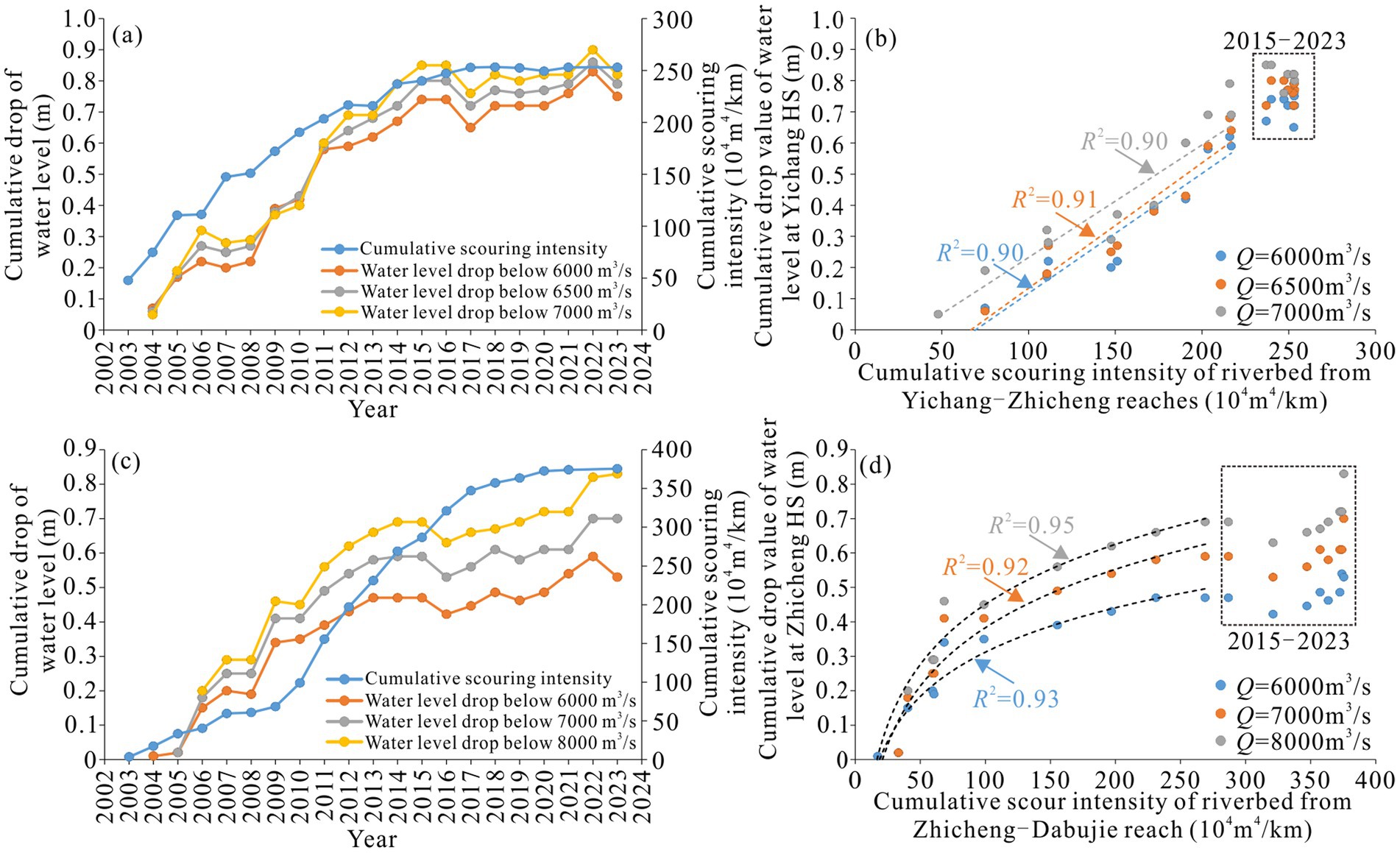
Figure 13. Relationship between water level decline and riverbed scouring in Yichang and Zhicheng HSs. (a) Cumulative relationship between water level at Yichang HS and scouring volume in the Yichang–Zhicheng reaches; (b) direct relationship between water level at Yichang HS and scouring volume in the Yichang–Zhicheng reaches; (c) cumulative relationship between water level at Zhicheng HS and erosion volume in the Zhicheng–Dabujie reaches; (d) direct relationship between water level at Zhicheng HS and scouring volume in the Zhicheng–Dabujie reaches.
4.3 Trend analysis of “steep slope and rapid flow” characteristics
From 2003 to 2023, the riverbed scouring in the Yichang–Zhicheng reaches occurred accumulative riverbed scouring, with the scouring intensity decreasing since 2014, and the corresponding changes in the same flow rate to low-water levels at the Yichang and Zhicheng HSs have remained relatively stable. In recent years, riverbed sand mining activities have been effectively controlled, and the scouring intensity in the Yichang–Zhicheng reaches will stay relatively low. It can be assumed that since 2014, the water surface slope in this section will tend to stabilize. From 2003 to 2023, the scouring intensity in the Zhicheng–Dabujie reaches has been increasing (Figure 2), but since 2014, the decrease in the same flow rate to low-water levels at Zhicheng HS has been smaller. Since 2003, the riverbed scouring intensity in the Shashi reach has increased (Yang et al., 2023c), leading to a decline in the water level at the Shashi HS under the same flow rate, aggravating the increase in water surface gradient from Zhicheng–Shashi reaches. Additionally, the maximum flow velocity has increased compared to the 1998–2006. This imbalance between riverbed scouring and the decline in the same flow rate to low-water levels is the main cause of the “steep slope and rapid flow” phenomenon in the Zhicheng–Dabujie reaches.
The river from Yichang–Dabujie is distributed with control nodes such as Yanzhiba, Yidu, Guanzhou, and Lujiahe. Mathematical model calculations show that the average riverbed scouring of 0.5–2.0 m at each node results in a water level decline at Yichang HS of less than 0.04–0.25 m, with the Lujiahe reach having the most significant impact. Scouring below Lujiahe does not affect the Yichang HS water level (Yang et al., 2016). When the water level in the sandy riverbed reach (Shashi reach) decreases by 2.0 m, the decrease propagates upstream and gradually decreases along the way; the water level at Chenerkou drops to 0.4 m and drops to less than 0.10 m at Yichang HS (Yu and Wang, 2024). Since 2003, the cumulative scouring intensity in the sandy riverbed in the middle and lower reaches of the Yangtze River has significantly increased. From 2003 to 2023, the water level at Shashi HS for Q = 6,000 m3/s dropped by 3.42 m. As the scouring center of the sandy riverbed shifts downstream (Zheng et al., 2023), the same flow rate to low water levels at Shashi, Jianli, Luoshan, and Hankou HSs also show a declining trend. The sandy riverbed sections will continue to experience riverbed scouring and a decrease in the same flow rate to low-water levels in the future.
With the effective regulation of sand mining activities in the Yangtze River, future riverbed scouring intensity in sandy-gravel reaches will primarily depend on variations in water-sediment dynamics and bed material composition. Following the commissioning of the TGR, the middle Yangtze River’s sandy-gravel riverbed has exhibited a pronounced coarsening trend (Gong et al., 2023; Wu et al., 2021; Wu and Singh, 2024; Yang et al., 2017; Chai et al., 2020). This coarsening process enhances bed resistance to scouring, thereby reducing scouring intensity, a critical factor explaining the diminished riverbed scouring observed under declining sediment supply conditions in the basin. Based on the above analysis, it is concluded that the sandy riverbed section will continue to experience riverbed scouring and a decrease in the same flow rate to low-water levels. The sandy-gravel riverbed reach will maintain low-level scouring and relatively stable water levels under the same flow rate without the interference of large-scale human activities; however, the phenomenon of “steep slope and rapid flow” in the sandy-gravel transition section will remain significant in the future.
5 Conclusion
This study focuses on the 120 km section of the Yangtze River downstream of the TGD (from Yichang to Dabujie reaches). Using actual flow, sediment, and riverbed topographic data from 2022 to 2023 to analyze the change characteristics in riverbed scouring intensity and distribution, same flow rate and low-water level, and the water surface gradient.
1. From 2003 to 2023, the cumulative scouring volume in the low-flow riverbed and the flat riverbed in the Yichang–Dabujie traches was 3.70 × 108 m3 and 3.72 × 108 m3, respectively, with approximately 99.5% of the scouring occurring in the low-water channel, accompanied by an average reduction in the deep-water channel elevation occurred, the average incision depth was 4.12 m, the average annual incision depth of was 19.62 cm/year, and the maximum incision depth was 23.40 m.
2. From 2003 to 2023, the Yichang–Dabujie reaches experienced a reduction in sandbar area and an increase in deep-water channel area, showing a good correlation. Since 2014, because of the implementation of waterway engineering, the variation in the sandbar and deep-water channel areas has been minimal and stayed relatively stable, indicating that waterway engineering has played a role in stabilizing sandbars and consolidating deep-water channels.
3. From 2003 to 2023, the Yichang–Dabujie reaches showed a cumulative decline in the same flow rate and low-water level, and the decrease in the sandy riverbed section was significantly greater than in the sandy-gravel riverbed section. This increased the water surface gradient, forming a “steep slope” phenomenon. As the scouring effect increased in the transition from sandy to sandy-gravel riverbeds, the flow velocity in the gravel-sand transition section increased, reaching a maximum of 3.50 m/s or more, forming a “steep slope and rapid flow” phenomenon.
4. In the near future, the sandy riverbed section near the TGD will continue to experience strong riverbed scouring and a decreasing trend in the same flow rate and low-water level. The sandy-gravel riverbed will maintain low-level scouring and relatively stable in the same flow rate to low-water levels without the interference of large-scale human activities, but the “steep slope and rapid flow” phenomenon in the sandy-gravel transition section will remain significant.
Data availability statement
The data analyzed in this study is subject to the following licenses/restrictions: data is available on request to the authors. Requests to access these datasets should be directed to YY, eWFuZ3NhbjUyMF81MjFAMTYzLmNvbQ==.
Author contributions
JL: Investigation, Methodology, Writing – review & editing. YY: Conceptualization, Funding acquisition, Writing – original draft, Writing – review & editing. ML: Conceptualization, Validation, Visualization, Writing – review & editing. XL: Data curation, Project administration, Writing – review & editing. CJ: Investigation, Project administration, Writing – review & editing. YL: Investigation, Methodology, Writing – review & editing.
Funding
The author(s) declare that financial support was received for the research and/or publication of this article. This study was funded by the National Natural Science Foundation of China (52279066), Guangxi Science and Technology Major Program (AA23023009), Fundamental Research Funds for Central Welfare Research Institutes (TKS20230105; TKS20240202), and supported by Hubei Provincial Natural Science Foundation of China (2023AFD201).
Conflict of interest
XL was employed by China Three Gorges Corporation. YL was employed by Hunan Provincial Communications Planning, Survey & Design Institute Co., Ltd.
The remaining authors declare that the research was conducted in the absence of any commercial or financial relationships that could be construed as a potential conflict of interest.
Generative AI statement
The authors declare that no Gen AI was used in the creation of this manuscript.
Any alternative text (alt text) provided alongside figures in this article has been generated by Frontiers with the support of artificial intelligence and reasonable efforts have been made to ensure accuracy, including review by the authors wherever possible. If you identify any issues, please contact us.
Publisher’s note
All claims expressed in this article are solely those of the authors and do not necessarily represent those of their affiliated organizations, or those of the publisher, the editors and the reviewers. Any product that may be evaluated in this article, or claim that may be made by its manufacturer, is not guaranteed or endorsed by the publisher.
References
Chai, Y., Yang, Y., Deng, J., Sun, Z., Li, Y., and Zhu, L. (2020). Evolution characteristics and drivers of the water level at an identical discharge in the Jingjiang reaches of the Yangtze River. J. Geogr. Sci. 30, 1633–1648. doi: 10.1007/s11442-020-1804-x
Cheng, W., Chen, L., Xu, W., and Zhou, Y. (2011). Relationship between water level and discharge of dam vicinity downstream three gorges reservoir after its impoundment. Eng. J. Wuhan Univ. 44, 434–439. doi: 10.1007/s12182-011-0123-3
Deng, S., Xia, J., Zhu, H., Liang, J., Sun, H., and Liu, X. (2024). Channel erosion and its impact on environmental flow of riparian habitat in the middle Yangtze River. Environ. Sci. Ecotechnol. 20:100403. doi: 10.1016/j.ese.2024.100403
Dong, Z., Huang, B., Li, M., and Gao, K. (2020). Maintenance dredging technology of Lujiahe waterway in middle of the Yangtze River. Port Waterw. Eng. 565, 90–96. doi: 10.3969/j.issn.1002-4972.2020.01.016
Ge, H., Zhu, L., Zhu, L., and Li, Y. (2009). Analysis of river evolution tendency at Zhijiang-Jiangkou reach after impoundment of three gorges reservoir. Eng. J. Wuhan Univ., 42, 470–473, 477.
Gong, Z., Wu, Z., An, C., Zhang, B., and Fu, X. (2023). CP3d: a comprehensive Euler-Lagrange solver for direct numerical simulation of particle-laden flows. Comput. Phys. Commun. 286:108666. doi: 10.1016/j.cpc.2023.108666
Guo, L., Su, N., Zhu, C., and He, Q. (2018). How have the river discharges and sediment loads changed in the Changjiang River basin downstream of the three gorges dam? J. Hydrol. 560, 259–274. doi: 10.1016/j.jhydrol.2018.03.035
Guo, W., Wang, B., Jiao, X., Huang, L., Yang, H., Yu, L., et al. (2024). Synergistic evolution and attribution analysis of water-sediment in the middle and lower reaches of the Yangtze River. J. Hydrol. Reg. Stud. 51:101626. doi: 10.1016/j.ejrh.2023.101626
Han, J., Sun, Z., Li, Y., and Yang, Y. (2017). Combined effects of multiple large-scale hydraulic engineering on water stages in the middle Yangtze River. Geomorphology 298, 31–40. doi: 10.1016/j.geomorph.2017.09.034
Hu, C., and Fang, C. (2017). Research on sediment problem solutions for the three gorges project and it operational effects. Sci. Sin. Tech. 47, 832–844. doi: 10.1360/N092017-0009
Hu, Y., Li, D., Deng, J., Yue, Y., Zhou, J., Yang, C., et al. (2024b). Dune development dominates flow resistance increase in a large dammed river. Water Resour. Res. 60:e2023WR036660. doi: 10.1029/2023WR036660
Hu, Y., Liu, C., Deng, J., Zhang, W., and Li, Y. (2024a). Flow resistance in the channel-bar landscape of large alluvial rivers. Front. Earth Sci. 18, 412–421. doi: 10.1007/s11707-022-1040-z
Li, M. (2017). Water lever changing law in dry season and its effects on navigation in the middle Yangtze River. Port Waterw. Eng. 527, 156–160. doi: 10.3969/j.issn.1002-4972.2017.04.026
Li, M., Hu, C., Zhou, C., and Peng, S. (2021). Analysis on the evolution mechanism of the“steep slope and rapid flow”section of Lujia waterway in the middle reaches of the Yangtze River under new conditions of water and sediment. J. Hydraul. Eng. 52, 158–168. doi: 10.13243/j.cnki.slxb.20200418
Li, T., Wang, S., Liu, Y., Fu, B., and Zhao, W. (2018). Driving forces and their contribution to the recent decrease in sediment flux to ocean of major rivers in China. Sci. Total Environ. 634, 534–541. doi: 10.1016/j.scitotenv.2018.04.007
Li, W., Wu, J., Du, H., Wan, Y., Yang, S., Xiao, Y., et al. (2020). Impact assessment of waterway development on the socioeconomic conditions and ecosystem in the upper Yangtze River. River Res. Appl. 38, 988–999. doi: 10.1002/rra.3955
Li, S., Zhu, L., Yuan, J., Dong, B., Lv, C., and Yang, C. (2025). Riverbed adjustments in gravel-sand reaches immediately downstream of large reservoirs. Sustainability 16:11245. doi: 10.3390/su162411245
Liu, H., Mao, C., and Li, M. (2010). Navigation obstruction and countermeasures of Lujiahe waterway on the middle stream of the Yangtze River. Port Waterw Eng. 439, 112–116. doi: 10.3969/j.issn.1002-4972.2010.03.024
Luo, F., Chen, D., Guo, Y., and Sun, Z. (2019). Erosion distribution in the near-dam reach of downstream after the three gorges project operation. J. Sediment. Res. 44, 31–38. doi: 10.16239/j.cnki.0468-155x.2019.03.006
Sun, Z., Li, Y., Ge, H., and Zhu, L. (2011). Channel erosion processes of transitional reach from gravel river bed to sand bed in middle Yangtze River. J. Hydraul. Eng. 42, 789–797. doi: 10.13243/j.cnki.slxb.2011.07.002
Sun, Z., Li, Y., Li, M., and Zhang, W. (2007). Investigation on water surface profile in the gravel bed reach of the middle Yangtze River: its current state and evolution trend. J. Sediment. Res. 5, 9–16. doi: 10.3321/j.issn:0468-155x.2007.05.005
Suo, W., Liu, L., Yu, H., and Zhang, M. (2020). Formation reason for falling barrier and channel regulation effect in Lujiahe waterway. Port Waterw. Eng. 567, 69–74. doi: 10.3969/j.issn.1002-4972.2020.03.012
Wang, S., Fu, B., Piao, S., Lü, Y., Ciais, P., Feng, X., et al. (2016). Reduced sediment transport in the Yellow River due to anthropogenic changes. Nat. Geosci. 9, 38–41. doi: 10.1038/NGEO2602
Wang, Y., Rhoads, B., Wang, D., Wu, J., and Zhang, X. (2021). Impacts of large dams on the complexity of suspended sediment dynamics in the Yangtze River. J. Hydrol. 558, 184–195. doi: 10.1016/j.jhydrol.2018.01.027
Weng, J., Liao, S., and Yang, D. (2020). Methodology for estimating waterway traffic capacity at Shanghai estuary of the Yangtze River. J. Navig. 73, 75–91. doi: 10.1017/S0373463319000493
Wu, Z., Chen, Y., Duan, C., Lin, J., Zheng, X., Huang, S., et al. (2025). Coordination between flood prevention capacity and urbanization under climate change in the Yangtze River Economic Belt, China. J. Water Clim Chang. 16, 1260–1280. doi: 10.2166/wcc.2025.377
Wu, Z., and Singh, A. (2024). Modeling riverbed elevation and bedload tracer transport resting times using fractional Laplace motion. J. Geophys. Res. Earth Surf. 129:e2024JF007771. doi: 10.1029/2024JF007771
Wu, Z., Singh, A., Foufoula-Georgiou, E., Guala, M., Fu, X., and Wang, G. (2021). A velocity-variation-based formulation for bedload particle hops in rivers. J. Fluid Mech. 912:A33. doi: 10.1017/jfm.2020.1126
Xiong, H., Sun, Z., Li, M., and Chen, L. (2020). Causes of local gravel deposition in gravel-sand transition of the middle Yangtze River under clear water scour. Adv. Water Sci. 31, 524–534. doi: 10.14042/j.cnki.32.1309.2020.04.006
Xiong, H., Sun, Z., Li, M., and Xu, M. (2019). Maintenance dredging scheme of Lujiahe waterway in middle of the Yangtze River. Port Waterw. Eng. 561, 106–112. doi: 10.3969/j.issn.1002-4972.2019.10.018
Xu, Q., Dong, B., Yuan, J., and Zhu, L. (2023). Scouring effect of the middle and lower reaches of the Yangtze River and its impact aftel the impoundment of the three gorges project. J. Lake Sci. 35, 650–661. doi: 10.18307/2023.0221
Yang, Y., Li, M., Liu, W., Chai, Y., Zhang, J., and Yu, W. (2023c). Relationship between potential waterway depth improvement and evolution of the Jingjiang reach of the Yangtze River in China. J. Geogr. Sci. 33, 547–575. doi: 10.1007/s11442-023-2096-8
Yang, Y., Zhai, P., Li, J., and Wang, Q. (2025). Rainbelt properties of persistent heavy precipitation over the Yangtze River basin and associated three-dimensional circulations. Weather Forecast. 40, 689–702. doi: 10.1175/WAF-D-24-0054.1
Yang, Y., Zhang, M., Liu, W., Wang, J., and Li, X. (2019). Relationship between waterway depth and low-flow water levels in reaches below the three gorges dam. J. Waterw. Port Coast. Ocean Eng. 145:04018032. doi: 10.1061/(ASCE)WW.1943-5460.0000482
Yang, Y., Zhang, M., Sun, Z., Han, J., and Wang, J. (2018). The relationship between water level change and river channel geometry adjustment in the downstream of the three gorges dam. J. Geogr. Sci. 28, 1975–1993. doi: 10.1007/s11442-018-1575-9
Yang, Y., Zhang, M., Sun, Z., Li, H., Jiang, L., Zhu, L., et al. (2016). Characteristics and reason of riverbed evolution difference in the middle Yangtze River based on river unit model. J. Basic Sci. Eng. 26, 70–84. doi: 10.16058/j.issn.1005-0930.2018.01.007
Yang, Y., Zhang, M., Zhu, L., Liu, W., Han, J., and Yang, Y. (2017). Influence of large reservoir operation on water-levels and flows in reaches below dam: case study of the three gorges reservoir. Sci. Rep. 7:15640. doi: 10.1038/s41598-017-15677-y
Yang, Y., Zheng, J., Wang, J., Liu, W., and Zhu, L. (2024a). Evolution of the shoal group coupling and its response mechanism to waterway engineering in the Daijiazhou reach of the middle reaches of the Yangtze River. Adv. Water Sci. 35, 830–842. doi: 10.14042/j.cnki.32.1309.2024.05.013
Yang, Y., Zheng, J., Zhang, H., Chai, Y., Zhu, Y., and Wang, C. (2020). Impact of the three gorges dam on riverbed scour and siltation of the middle reaches of the Yangtze River. Earth Surf. Process. Landf. 47, 1514–1531. doi: 10.1002/esp.5332
Yang, Y., Zheng, J., Zhang, M., Wang, J., and Chai, Y. (2024b). Impacts of human activities on the riverbed morphological in the tidal reaches of the Yangtze River. J. Hydrol. 630:130735. doi: 10.1016/j.jhydrol.2024.130735
Yang, Y., Zheng, J., Zhang, M., and Zhu, L. (2023b). Sediment sink-source transitions in the middle and lower reaches of the Yangtze River estuary. Front. Mar. Sci. 10:1201533. doi: 10.3389/fmars.2023.1201533
Yang, Y., Zheng, J., Zhang, M., Zhu, L., Zhu, Y., Wang, J., et al. (2021). Sandy riverbed shoal under anthropogenic activities: the sandy reach of the Yangtze River, China. J. Hydrol. 603:126861. doi: 10.1016/j.jhydrol.2021.126861
Yang, Y., Zhou, L., Zhu, L., Liu, W., and Wang, J. (2023a). Impact of upstream reservoirs on geomorphic evolution in the middle and lower reaches of the Yangtze River. Earth Surf. Process. Landf. 48, 582–595. doi: 10.1002/esp.5504
Yu, W., and Wang, J. (2024). Study of impact on channel flow characteristics by dredging in Yichang-Dabujie reach of Yangtze River. Water Resour. Power 42, 192–196. doi: 10.20040/j.cnki.1000-7709.2024.20230772
Zhang, X., Yang, Y., Li, M., Zhang, M., Wang, J., and Xin, W. (2023). Waterway channel stability and management measures of Chenglingji-Wuhan reaches in the middle section of the Yangtze River. Water 15:2047. doi: 10.3390/w15112047
Zhang, W., Yang, Y., Zhang, M., Li, Y., Zhu, L., You, X., et al. (2017). Mechanisms of suspended sediment restoration and bed level compensation in downstream reaches of the three gorges projects (TGP). J. Geogr. Sci. 27, 463–480. doi: 10.1007/s11442-017-1387-3
Zhao, W., Yang, Y., Zhang, H., Zhang, M., Yuan, J., and Yang, B. (2020). Adjustment patterns and causes of the morphology of sandy riverbed downstream of the three gorges dam. Adv. Water Sci. 31, 862–874. doi: 10.14042/j.cnki.32.1309.2020.06.006
Zheng, S., An, C., Wang, H., Li, L., Wang, F., and Hassan, M. (2023). The migration of the erosion center downstream of the three gorges dam, China, and the role played by underlying gravel layer. Water Resour. Res. 59:e2022WR034152. doi: 10.1029/2022WR034152
Zhou, W., Sun, Z., Zhou, K., Li, Z., and Chen, L. (2022). Characteristics of discharge frequency and their effects on flood channel formation in the middle and lower reaches of the Yangtze River before/after the impoundment of the three gorges reservoir. J. Lake Sci. 34, 616–629. doi: 10.18307/2022.0221
Keywords: steep slopes, rapid flow, river channel evolution, Three Gorges Project, Yangtze River
Citation: Liu J, Yang Y, Li M, Liu X, Ji C and Liu Y (2025) Study on the evolution of the sandy-gravel riverbed and the characteristics of channel hydrodynamic force after the operation of the Three Gorges Project. Front. Water. 7:1579728. doi: 10.3389/frwa.2025.1579728
Edited by:
Hafzullah Aksoy, Istanbul Technical University, TürkiyeCopyright © 2025 Liu, Yang, Li, Liu, Ji and Liu. This is an open-access article distributed under the terms of the Creative Commons Attribution License (CC BY). The use, distribution or reproduction in other forums is permitted, provided the original author(s) and the copyright owner(s) are credited and that the original publication in this journal is cited, in accordance with accepted academic practice. No use, distribution or reproduction is permitted which does not comply with these terms.
*Correspondence: Yunping Yang, eWFuZ3NhbjUyMF81MjFAMTYzLmNvbQ==; Xinbo Liu, bGl1X3hpbmJvQGN0Zy5jb20uY24=
 Juntao Liu1,2
Juntao Liu1,2 Yunping Yang
Yunping Yang Chao Ji
Chao Ji Yongsheng Liu
Yongsheng Liu
